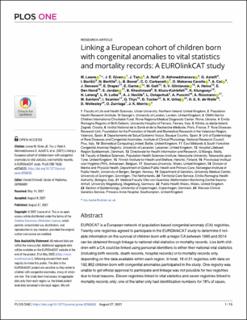| dc.contributor.author | Loane, Maria | |
| dc.contributor.author | Given, Joanne E. | |
| dc.contributor.author | Tan, J. | |
| dc.contributor.author | Reid, A. | |
| dc.contributor.author | Akhmedzhanova, D. | |
| dc.contributor.author | Astolfi, G. | |
| dc.contributor.author | Barisic, Ingeborg | |
| dc.contributor.author | Bertille, N. | |
| dc.contributor.author | Bonet, L.B. | |
| dc.contributor.author | Cavero-Carbonell, Clara | |
| dc.contributor.author | Carollo, O. Mokoroa | |
| dc.contributor.author | Coi, Alessio | |
| dc.contributor.author | Densem, J. | |
| dc.contributor.author | Draper, Elizabeth S. | |
| dc.contributor.author | Garne, Ester | |
| dc.contributor.author | Gatt, Miriam | |
| dc.contributor.author | Glinianaia, S.V. | |
| dc.contributor.author | Heino, Anna | |
| dc.contributor.author | Hond, E. Den | |
| dc.contributor.author | Jordan, Sue | |
| dc.contributor.author | Khoshnood, Babak | |
| dc.contributor.author | Kiuru-Kuhlefelt, S. | |
| dc.contributor.author | Klungsøyr, Kari | |
| dc.contributor.author | Lelong, Nathalie | |
| dc.contributor.author | Lutke, L.R. | |
| dc.contributor.author | Neville, Amanda J. | |
| dc.contributor.author | Ostapchuk, L. | |
| dc.contributor.author | Puccini, Aurora | |
| dc.contributor.author | Rissmann, Anke | |
| dc.contributor.author | Santoro, Michele | |
| dc.contributor.author | Scanlon, I. | |
| dc.contributor.author | Thys, G. | |
| dc.contributor.author | Tucker, David | |
| dc.contributor.author | Urhoj, Stine Kjaer | |
| dc.contributor.author | De Walle, H. E. K. | |
| dc.contributor.author | Wellesley, Diana | |
| dc.contributor.author | Zurriaga, O. | |
| dc.contributor.author | Morris, Joan K. | |
| dc.date.accessioned | 2022-03-01T07:50:30Z | |
| dc.date.available | 2022-03-01T07:50:30Z | |
| dc.date.created | 2022-02-02T14:11:07Z | |
| dc.date.issued | 2021 | |
| dc.identifier.issn | 1932-6203 | |
| dc.identifier.uri | https://hdl.handle.net/11250/2981908 | |
| dc.description.abstract | EUROCAT is a European network of population-based congenital anomaly (CA) registries. Twenty-one registries agreed to participate in the EUROlinkCAT study to determine if reliable information on the survival of children born with a major CA between 1995 and 2014 can be obtained through linkage to national vital statistics or mortality records. Live birth children with a CA could be linked using personal identifiers to either their national vital statistics (including birth records, death records, hospital records) or to mortality records only, depending on the data available within each region. In total, 18 of 21 registries with data on 192,862 children born with congenital anomalies participated in the study. One registry was unable to get ethical approval to participate and linkage was not possible for two registries due to local reasons. Eleven registries linked to vital statistics and seven registries linked to mortality records only; one of the latter only had identification numbers for 78% of cases, hence it was excluded from further analysis. For registries linking to vital statistics: six linked over 95% of their cases for all years and five were unable to link at least 85% of all live born CA children in the earlier years of the study. No estimate of linkage success could be calculated for registries linking to mortality records. Irrespective of linkage method, deaths that occurred during the first week of life were over three times less likely to be linked compared to deaths occurring after the first week of life. Linkage to vital statistics can provide accurate estimates of survival of children with CAs in some European countries. Bias arises when linkage is not successful, as early neonatal deaths were less likely to be linked. Linkage to mortality records only cannot be recommended, as linkage quality, and hence bias, cannot be assessed. | en_US |
| dc.language.iso | eng | en_US |
| dc.publisher | Public Library of Science | en_US |
| dc.rights | Navngivelse 4.0 Internasjonal | * |
| dc.rights.uri | http://creativecommons.org/licenses/by/4.0/deed.no | * |
| dc.title | Linking a European cohort of children born with congenital anomalies to vital statistics and mortality records: A EUROlinkCAT study | en_US |
| dc.type | Journal article | en_US |
| dc.type | Peer reviewed | en_US |
| dc.description.version | publishedVersion | en_US |
| dc.rights.holder | Copyright © 2021 Loane et al | en_US |
| dc.source.articlenumber | e0256535 | en_US |
| cristin.ispublished | true | |
| cristin.fulltext | original | |
| cristin.qualitycode | 1 | |
| dc.identifier.doi | 10.1371/journal.pone.0256535 | |
| dc.identifier.cristin | 1996998 | |
| dc.source.journal | PLOS ONE | en_US |
| dc.identifier.citation | PLOS ONE. 2021, 16 (8), e0256535. | en_US |
| dc.source.volume | 16 | en_US |
| dc.source.issue | 8 | en_US |

